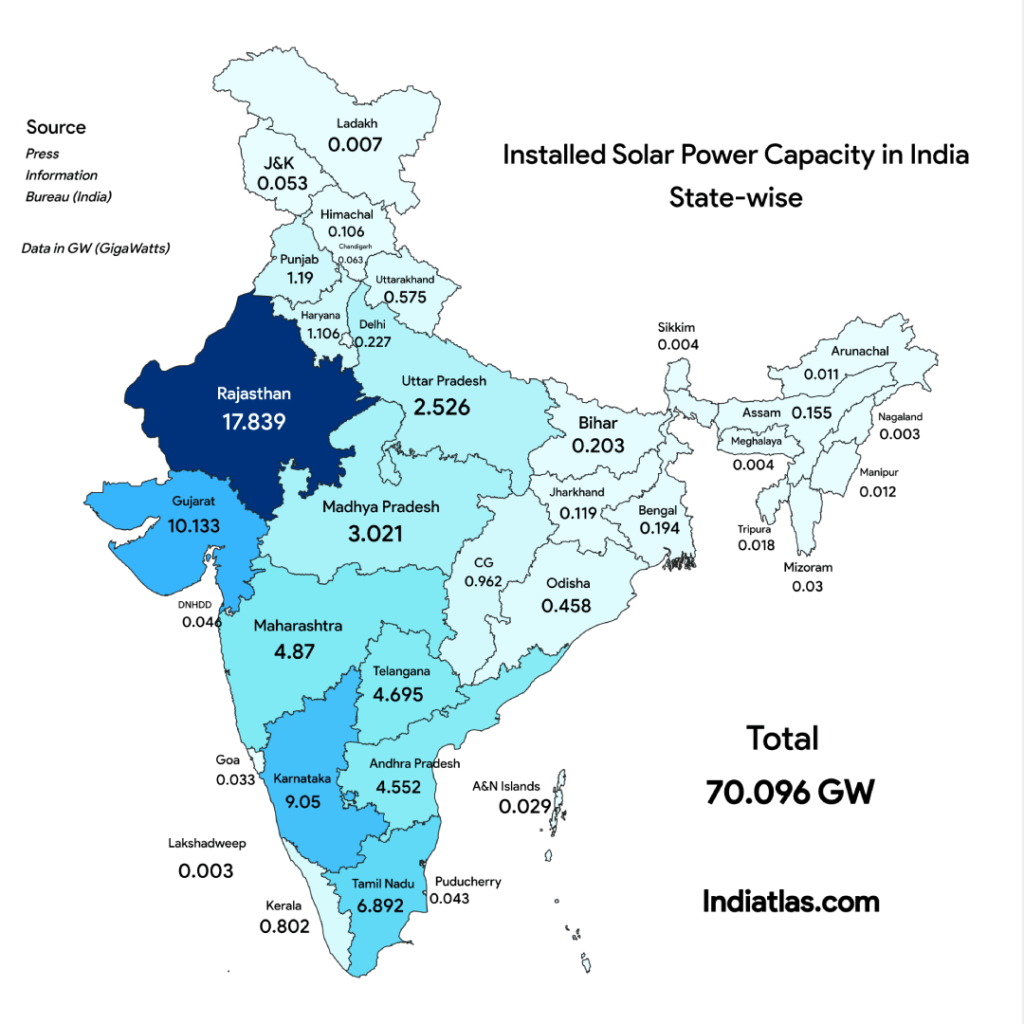As India moves towards an installed capacity of 500GW renewable energy by 2030, the Top 10 solar energy producing states in India are at the forefront of achieving this goal.
India is taking significant steps to harness solar energy. Its geographical diversity provides the ground for Solar energy Innovations.
Let’s look into the factors that made these states stand among the Top 10 solar energy producing states in India, along with their contributions to the nation’s solar energy production goals.

1. Rajasthan

The state of Rajasthan is the highest solar energy producing state in India, with an installed solar capacity of 17.83 GW (Giga Watts) and production of 34474 MU of solar energy.
This state also emerged as a hub for manufacturing and assembling solar power components.
The vast arid landscapes of this state, the abundant sunlight, and the hot desert regions acted as a ground to make this state stand first in the top 10 solar energy producing states in India.
Due to its geographical location, this state has few cloudy days and benefits from sunny days throughout the year.
Moreover, Rajasthan receives high levels of solar radiation ranging from 6-7 kWh/m2/day. This makes this state a top location for solar energy projects in India.
Several large-scale solar parks and solar energy clusters in this state, like the Bhadla Solar Park cluster and Barmer Solar & Wind Energy cluster, contribute significantly to the state’s solar energy output.
The Bhadla Solar Park is the world’s largest solar power project in India and the world.
Rajasthan Government policies promoting renewable energy have also attracted several investments in solar energy.
The solar power potential of Rajasthan has been assessed at 142GW, and it is now on track to produce 30 GW of solar power by the end of 2025.
2. Gujarat
With an installed solar capacity of 10.13 GW, Gujarat stands second among the solar energy producing states. This state generated 10335 MU of solar power in 2022-23.
Being a great player in the manufacturing of solar energy components and having vast open spaces, an arid climate, and abundant sunlight for solar energy production, Gujarat quickly emerged as one of the leaders in the Solar energy Industry in India.
Gujarat has the potential to produce 36GW of Solar power.
The state government’s robust policies encouraged investments in solar energy, focusing on the production of power and manufacturing of solar systems.
The subsidy schemes provided in Gujarat also helped farmers and households install solar rooftops and pumps for agriculture. These steps significantly increased the installed solar capacity in this state.
Gujarat aims to double its solar capacity in the next five years to contribute to the national energy goals and become a sustainable energy state.
3. Karnataka
The southern state of Karnataka stands third in this list, with an installed capacity of 9.05 GW of solar energy and generating 14153 MU of solar power.
Karnataka had rapidly emerged as a solar energy producing state in India. It is primarily due to the presence of several regions with favourable climatic conditions.
The state policy on solar energy and renewable energies has increased substantial investments and to adopt advanced technologies in this field.
The Government also offers several incentives for residential and agricultural installations, boosting energy production.
The Pavagada Solar Park in Tumkur is India’s second-biggest solar power plant.
Karnataka’s estimated solar potential is 25 GW, and it has an average insolation of more than 5kWh/m2/day.
The state is now focusing on installing floating solar panels in 40 lakes to harness 2500 MW of solar energy.
4. Tamil Nadu
Another Southern Indian State, Tamil Nadu, is known for its renewable energy production.
Tamil Nadu has an installed solar capacity of 6.89 GW and generated 9419 MU of solar energy during 2022-23.
The hot climate, ample sunlight, and high solar insolation levels make Tamil Nadu an ideal location for solar power generation.
Regions like Madurai and Trichy are well-suited for solar installations. Several large-scale solar power projects present in these areas not only generate energy but also support local employment and economy.
This state had also started several initiatives to encourage the installation of solar energy for residential and commercial purposes, which further contributed to solar energy output in this state.
The Adani’s Kamuthi solar power project in Ramanathapuram district is the world’s largest single-location solar power project. It spans an area of 2500 acres and contributes 648 MW (0.648GW) of solar power.
5. Telangana
Telangana stands fifth among the top 10 solar energy producing states in India, with a cumulative solar capacity of 4.69 GW. The state had generated 6745 Mu of solar power for the years 2022-23.
This state has a vast solar energy potential of over 20.41 GW. Several regions in this state have landscapes that favour solar energy production.
Policies implemented in this state are attracting investors to establish new solar plants. At the same time, the policy also favours investments to establish manufacturing units to generate solar systems and components.
The Government invested in innovative solar energy models like floating water solar plants and agrivoltaics.
An interesting fact is that Telangana has adopted a decentralized distribution of solar energy projects instead of big solar parks or clusters.
6. Maharastra
With an installed solar power capacity of 4.87 GW, Maharashtra is one of the top solar energy producing states.
This state has a huge solar potential to generate solar power and has produced 4387 MU of solar energy.
Clear sunlight is available for 250 to 300 days in Maharashtra, with radiation up to 6 5kWh/m2/day favouring power generation.
Maharashtra has set its policies and is providing subsidies to increase investments in solar energy and meet the growing energy demands in the state.
Large-scale solar parks like Sai Guru Solar Park and Dondaicha Solar Parks contribute hugely to the state’s solar energy output.
The state and national power generation cooperations are set to set up an ultra mega solar park that generated 2.5 GW of green power in Maharashtra.
7. Andhra Pradesh
With a cumulative solar power capacity of 4.55 GW, Andhra Pradesh stands seventh in the list of Top 10 solar energy producing states in India.
Andhra Pradesh has generated 8140.72 MU of solar power during 2022-23. This state has a solar potential of approximately 38.50 GW.
The state government has implemented several policies aimed at promoting renewable energy. Several incentives and schemes have been introduced to encourage investments in solar energy and the installation of solar rooftops and pump sets.
Several regions in Anantapur, Kurnool and Sri Satya Sai districts are well suited for solar energy plants due to the high solar radiation and availability of barren lands for projects.
The Kurnool ultra mega solar park with a capacity of 1GW and NP Kunta ultra mega solar park with 0.978 GW capacity in Andhra are among India’s largest solar plants.
Also, the Government has laid the foundation for the world’s largest integrated renewalble energy storage project by the Greenko group. This plant has a capacity of 5.23GW of renewable energy, of which 3GW is generated by solar. This further boosts the state and the country’s solar energy production.
8. Madhya Pradesh
Madhya Pradesh has quickly emerged as one of the significant players in India’s solar energy landscape.
This state has an installed solar power capacity of 3.02GW and has produced 3839 MU of electricity by harnessing solar energy.
The state government policies and incentives, such as feed-in tariffs and land bank facilitation, had helped to attract investments in the solar energy field.
The presence of abundant sunlight, clear skies for about 300 days and a solar irradiation of 5.5 kWh/m2/day make this state best suited for investments in solar energy plants.
Madhya Pradesh has a huge solar energy potential of 61 GW. The Government plans to develop three new floating solar power plants.
9. Uttar Pradesh
The state of Uttar Pradesh has an installed capacity of 2.52 GW solar energy and produced 3674MU of solar power in the years 2022-23.
This state has a solar potential of 22.83 GW and has taken several steps to increase its installed capacity.
Having good solar radiation, adequate sunlight for around 300 days, available land mass, and investment-friendly policies make Uttar Pradesh a great start for solar investments.
The solar energy policy of the state government aims to set up 22GW of solar power projects by 2027. Of this 14GW capacity is added through solar parks and 8GW through solar rooftop projects.
The state government is also taking necessary initiatives to implement the policy in time.
10. Haryana
With an installed capacity of 1.1GW of solar power, Haryana has increased its solar power capacity over the years and currently stands tenth among the top 10 solar energy producing states in India.
This state had produced 555MU of solar power during the years 2022-2023
State government incentives like subsidies, tax breaks, and quick approval processes have helped attract domestic and international investment.
Haryana state had promoted rooftop solar installations on residential and commercial sites and to adopt solar energy. Additionally, the Government offered attractive subsidies for installing solar rooftops.
An interesting fact is that rooftop solar projects account for 68% of the state’s overall solar capacity.
Haryana’s solar power policy also includes several benefits that are attracting investments in utility-scale solar energy projects and parks.









